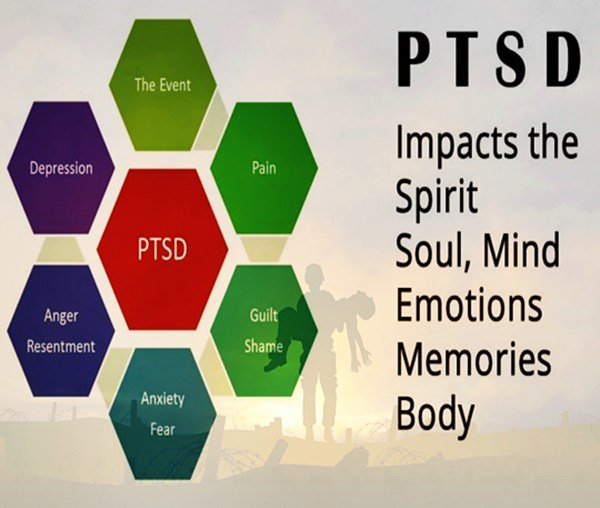The Onset of Psychiatric Diagnosis of Posttraumatic Stress Disorder
The Onset of Psychiatric Diagnosis of PostTraumatic Stress Disorder

Image Source
We have discussed PTSD as though it has dependably been with us. PTSD has just been a formal psychiatric diagnosis since 1980. The way that presentation to overwhelmingly unnerving occasions can prompt psychological distress has been around in the common sense database of human information for thousands of years.
Psychiatry and psychology as callings have been unquestionably irresolute about the truth of whether the experience of specific occasions can forever and essentially modify individuals' mental health. Prickly inquiries, for example, regardless of whether posttraumatic stress is physical or psychological, whether the trauma causes the issues or the issues are an element of pretrauma vulnerabilities, or whether posttraumatic stress patients are malingering or some way or another inadequate in character.
A watershed in our comprehension of the relationship of trauma to the mind happened around the end of the nineteenth century and the start of the twentieth century. As of now, two patriarchs of the psychotherapy world, Pierre Janet and Sigmund Freud, both defined thoughts regarding the connection amongst trauma and the brain.
Pierre Janet depicted a sum of 591 patients and announced a traumatic reason for their issues in 257 of them. Janet contended that when individuals experienced overpowering feelings, their brains might be not able fit this unnerving traumatic experience into their current mental representation of the world.
Accordingly, the memories of the experience won't be coordinated into the individual's own particular awareness and, rather, these memories will be separated from or separated from cognizance and, subsequently, from any deliberate control. Trauma, at that point, waits in memory inside the oblivious and barges in when the individual's psychological resistances are powerless or traded off.

Image Source
Breuer and Freud drew on this work of Janet in their renowned book Studies on Hysteria. They contended that 'Hysterics experience the ill effects of memories. The traumatic experience keeps on affecting on the patient. Through these meddling memories the patient moves toward becoming focused on the trauma. Afterward, Freud was to focus all the more particularly on instances of alleged hysteria where he broadly and dubiously contended that a gifted experience of sexual relations, coming about because of sexual mishandle conferred by someone else, is the particular reason for hysteria.
This apparently awesome progress in our comprehension of the idea of the brain, pioneered by Freud, was, nonetheless, turned on its head inside a couple of years when Freud abandoned what had come to be known as the seduction hypothesis and expressed, interestingly, that hysteria in adults was an element of dreams about early sexual experiences, instead of a consequence of genuine sexual experiences.
Following the two World Wars in the twentieth century there were brief restorations of the view that there is a connection between honest to goodness trauma and psychological distress. Nonetheless, notwithstanding when he was looked with indisputable proof that the experiences of psychologically distressed soldiers coming back from the front with shell stun had their starting points in bona fide trauma, as opposed to in some type of imagination, Freud stayed unconvinced and ended up proposing two speculations of posttraumatic stress.
One depended on what he called excruciating circumstances, for example, combat, and the other on what he called 'unsatisfactory impulses', which does not need its sources in bona fide trauma. This qualification was helped by the view that hysteria was fundamentally an issue endured by women though combat stress was endured primarily by men.
From the earliest starting point of the twentieth century until the 1970s, the recommendation that posttraumatic stress was a real psychological response to outside occasions was advanced by just a couple of lone voices, for example, Kardiner. Undoubtedly, it was not until the development of the women's movement, joined with swathes of traumatized soldiers coming back from the American war in Vietnam, that a resurgence in commitment to the possibility that psychological distress can have its starting point in outside traumatic occasions came to fruition.

Image Source
In 1974, Anne Burgess and Linda Holstrom at the Boston City Hospital in the US first depicted what they called 'rape trauma syndrome', taking note of that the experiences of flashbacks, bad dreams and nosy contemplations and pictures looked like the traumatic neuroses of war that had been portrayed by Kardiner and his associates.
At around a similar time, deliberate work on battered children and family savagery started to be done. Step by step, the boundless sexual mishandle of children and the decimation that it caused came to be documented. In spite of this, a main US textbook of psychiatry in 1980 still guaranteed that incest happened to less than one out of a million women and that its effect was not especially harming.
Advances in our comprehension of trauma and a more prominent spotlight on the poisonous impacts of childhood sexual mishandle as an element of the women's movement were paralleled in another domain by the development of RAP groups comprising of as of late returned Vietnam veterans.
In these RAP groups, veterans discussed their war experiences and started to dig into the literature of Kardiner and different psychiatrists who had worked with trauma victims from the First and Second World Wars. In light of these experiences, the RAP groups made a rundown of the 27 most common manifestations of traumatic stress that were accounted for in the literature and contrasted these and more than 700 clinical records of Vietnam veterans. Through this procedure they could whittle down the indication rundown to what they viewed as the most basic elements.

Image Source
References:
The Dissociation Theory of Pierre Janet
Janet and Freud: Revealing the Roots of Dynamic Psychiatry
A Neglected Intellectual Heritage
Studies on Hysteria
Post-traumatic Stress: The History of a Concept
Toward an Understanding of Post-Traumatic Stress Disorders
Victim Impact
Posted from my blog with SteemPress : https://steemme.000webhostapp.com/2018/07/the-onset-of-psychiatric-diagnosis-of-posttraumatic-stress-disorder
Thanks for the post, dianargenti.
I hope you don't mind if I test out some sentiment analysis on your post. This is an experimental bot running on a small % of posts, and if reaction is positive I'll increase that ratio and add features.
Your post had an average negative sentiment of 0.17 and an average positive sentiment of 0.04
The most positive sentence in your post had a positivity score of 0.166:
"This apparently awesome progress in our comprehension of the idea of the brain, pioneered by Freud, was, nonetheless, turned on its head inside a couple of years when Freud abandoned what had come to be known as the seduction hypothesis and expressed, interestingly, that hysteria in adults was an element of dreams about early sexual experiences, instead of a consequence of genuine sexual experiences."
The most negative sentence in your post had a negativity score of 0.412:
"They contended that 'Hysterics experience the ill effects of memories."